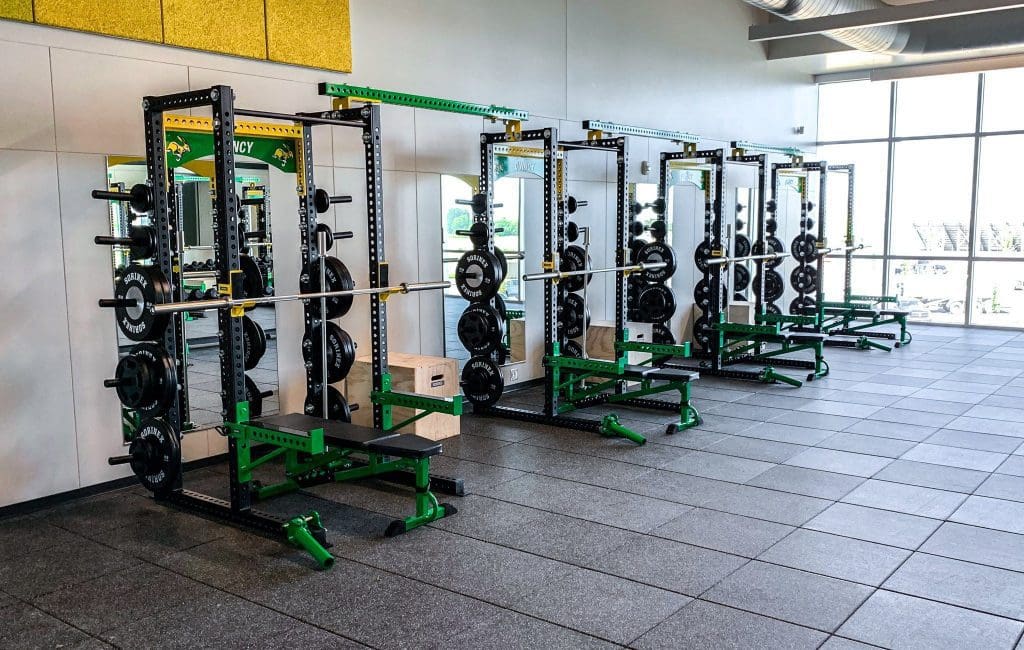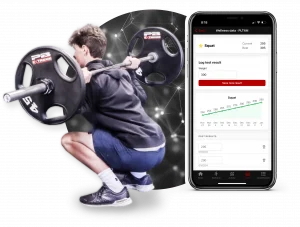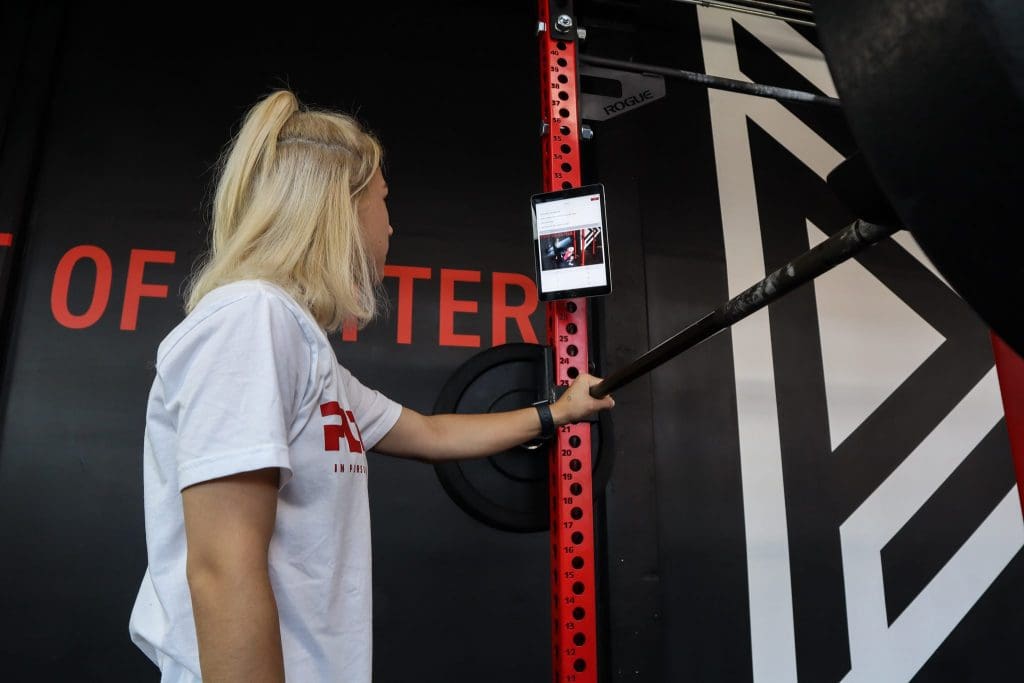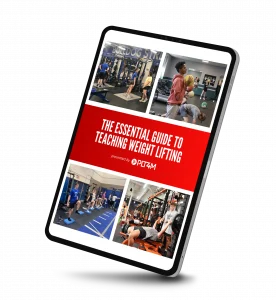Weight training is a personal fitness skill that can help students with their overall wellness journey. Incorporating weight training lesson plans for high school students can promote lifelong physical activity. To help students feel confident with weightlifting, physical education classes can begin with introducing strength training.
Struggling to find a high school weight training curriculum?
Most high school students want to head right to the bench press and bicep curls when they walk into a weight room. They want to see muscular strength, and they want to see it now!
But most high school students lack the appropriate fundamentals when it comes to resistance training and strength training.
While there used to be worksheets and programs like BFS, finding a curriculum for physical education classes that is engaging and appropriate for the weight room is hard!
Producing high school weight training lesson plans is challenging!
Teaching weightlifting is more than just handing out weight training worksheets. Lesson plans need to cover everything from lifting techniques to what muscle groups different exercises target.
The goal is to empower students to walk into any weight room and feel confident that they can exercise safely and effectively.
Doing this in a physical education setting with a diverse group of students is no simple task!

Essential questions for your high school weight training class?
As a teacher trying to develop lesson plans, there are a few important questions to ask at the beginning of any semester or year. Asking these questions can help address and identify what type of weight training lesson plans are most appropriate for your classroom.
What experience level/levels are my students?
While students might be in a weight training class, they might not even grasp bodyweight movements like the squat, lunge, hinge, etc. So before jumping right into loaded variations with dumbbells and barbells, it may make sense to do some bodyweight review.
On the other hand, advanced students or athletes in class may have covered the fundamentals and can go right into a more advanced strength and conditioning program with free weights.
Understanding what group or groups you have in class will help determine the right plan for you!
What type of space/equipment/and time do you have in class?
One of the more significant considerations for your class or curriculum will be based on the pure logistics of your situation.
Most high school weight rooms require some teacher and coach ingenuity to maximize the time and space. Regardless of what specific considerations your school and class have, having a plan in place can make all the difference.
Schools across the country are getting into the weight room! Check out a glimpse through a few social media posts below!
Sophomore personal wellness starting our @PLT4M Personal Fitness program today. We worked back squat, pistols, hammy bucks, and a finisher. This group brought tremendous focus and energy and challenged themselves with adding appropriate resistance! #ChampionsOfWellness pic.twitter.com/BAqH2vpM6d
— Canton Strength & Conditioning, CSCS (@CantonSC1) October 20, 2021
Here is a sample from our Personal Development and Fitness (PDF) class. The room was buzzing, everyone working to get better! And… This is the end of the workout! @ShenAthletics ShenAthletics @PLT4M Thanks for a great class block 3! pic.twitter.com/CwFI1kN8XE
— Shen Strength and Conditioning (@ShenFitness) December 16, 2021
A closer look at an intro to strength training unit in a weight room
For the purposes of this article, let’s assume you have a group of students that have never had a formal introduction to strength training. Chances are they have some free weights in the basement or have gone to the local YMCA, but their overall understanding of lifting techniques is pretty minimal.
Giving students an introduction to the weight room is about teaching them the total picture: an introduction to the world of barbells and dumbbells. So in this first introductory unit, the primary focus can start with the three powerlifts: back squat, bench press, and deadlift.
Lesson Plan Format
Each training session begins with a brief guided warm up, followed by auxiliary work like core supersets, plyometrics, or loaded carries. Then, we focus on the barbell with a concerted effort paid to learning and practicing the core lift of the day. Lastly, we wrap up our instruction with 2 accessory strength movements performed “outside of the rack” with dumbbells, bands, or other equipment. If time allows, we also suggest time spent through intentional cool down and active recovery.

Ready To Raise The Bar?
Our platform is the #1 choice for coaches and teachers looking to take their program to the next level. Learn how you can save time, improve results, and increase student engagement.
Lesson 1: Back Squat Focus
Once we have mastered the foundational air squat (and only then), the first pure strength variation we introduce is the “High Bar Back Squat”. The back squat, along with the bench press and barbell deadlift, is one of the 3 “Power Lifts” and is widely considered one of the best tools for developing full body strength, mobility, and stability.
You may see other programs and trainers utilize a “Low Bar” back squat. While this is also great tool for pure strength development, we feel the low bar variation is difficult to perform well by new athletes. It often turns into some sort of good morning/squat hybrid that goes against all of our movement tenets. Thus, we aim to first master the High Bar squat when training our high school athletes.
The loaded back squat is relatively simple in it’s execution, so long as you always keep all 4 points of squat performance in mind during every rep.
When squatting with a barbell, though, what we must pay attention to goes well beyond the squat movement pattern itself. How to set up for the lift properly, how to navigate the rack, how to prepare for and execute a failed lift, and so on. These elements may not seem hugely important, especially at the beginning when using little to no weight, but they will be SUPREMELY importnat down the road.
Today our focus is on learning the movement as a whole and practicing with VERY light weight. This is about accumulating experience with a new skill, not trying to move big weights! Watch the video closely, and pay attention to the details. The more we soak up now, the easier things will be in the long run.
After squatting, we will also quickly introduce a new loaded variation of the overhead press and hinge movement patterns. Be sure to watch the video and understand the basic points of performance before grabbing weights. Remember, we care about form more than weight!
That being said, please remember to RECORD the weights (DBs, Bands, etc) you use when prompted. This will allow your teacher to see what you’ve done, and also give you the opportunity to reference your work in future lessons!
Warm Up
Begin first by getting 1:00 of ANY light cardio in – jog/bike/row/jumping jacks/etc. Then, perform the following progression:
1 Min Alt. Spiderman & Reach
5 Air Squats
1 Min Pigeon Pose, each side (:30 each side)
5 Air Squats
1 Min Low Dragon, each side (:30 each side)
5 Air Squats
Core Superset
3 Rounds of:
:30 Elbow Plank
:30 Slow Superman Repetitions
:30 Rest
Little core superset to fire up the midline. First we perform 30 seconds of an ACTIVE elbow plank. Assume proper position, keep the spine neutral, and squeeze the abs intentionally. After 30 seconds, move to your superman.
Introduction To Barbell Back Squat
Today we are taking the first step towards our first barbell squat pattern, the “Back Squat”. This means we hold a bar across the back of our shoulders while performing the same squat pattern we mastered through bodyweight and light external objects held up against the chest.
For today, we are NOT looking to load up weight. Instead, we want to get extremely comfortable with the position of the bar on our backs, how to get into and out of a “rack”, and get some lightweight volume practice done.
Let’s use an “empty bar” for all of our reps, today. That could mean a full men’s olympic barbell, a women’s bar, a training bar, or even a PVC. It does not matter!
Focus on moving slow and with perfect technique!
Single Arm Strict Press
3 x 8 reps each arm
Now we are going to learn and practice a variation of the overhead press: the single arm strict press, performed in a half-kneeling position.
The key to this movement lies in proper positioning. Keep the core stacked, and weight pressed directly along the midline. No leaning back, or allowing the weight to come forward. Keep everything strict and slow.
Looking for just a LIGHTWEIGHT DB, moved with total control for about 8 reps per arm. RECORD the weight of the DB used (single DB wt) in each of your 3 Sets below. We will reference back to these weights next week!
RDL
Next we evolve our hinge pattern through a weighted variation called an “RDL” or Romanian Deadlift, also known as a straight legged deadlift.
A weight will be held in both hands in front of the body. After assuming a soft knee stance, feet under the hips, we will hinge forward, keeping the arms long and loose. We continue only as far as we can keep a good neutral spine, without bending the knees further, then we return to stand tall.
The key to this movement lies in proper back/knee position. This must be a true HINGE. Don’t reach for the floor, just hinge at the hip.
Looking for just a LIGHT WEIGHT, moved with total control for 8 reps. RECORD the weight of the DB used in each of your 3 Sets below. We will reference back to these weights next week!
Next we evolve our hinge pattern through a weighted variation called an “RDL” or Romanian Deadlift, also known as a straight legged deadlift.
A weight will be held in both hands in front of the body. After assuming a soft knee stance, feet under the hips, we will hinge forward, keeping the arms long and loose. We continue only as far as we can keep a good neutral spine, without bending the knees further, then we return to stand tall.
The key to this movement lies in proper back/knee position. This must be a true HINGE. Don’t reach for the floor, just hinge at the hip.
Looking for just a LIGHT WEIGHT, moved with total control for 8 reps. RECORD the weight of the DB used in each of your 3 Sets below. We will reference back to these weights next week!
Recovery
If time allows, get some proactive recovery done through a small cool-down session. Couple minutes of super easy cardio (bike/elliptical is great), then some static stretching or foam rolling. Trust us when we say taking 5 minutes to get this done will add up over time much to your benefit!
Free E-Book
Essential Guide to Teaching Weight Training
Discover the five essential steps to initiate or scale up your weight training program.
Lesson 2: Bench Press Focus
Today we introduce our second “Power Lift”, the Bench Press!
While many think of the bench as a simple lift, and one only for beach body “bro” pumps, it is actually a great place for all to begin developing full body pressing strength, and does require some attention to detail in it’s execution.
As with our Back Squat, there is much more that goes into barbell pressing work than the foundational movement pattern. We must set ourselves and our equipment up in the rack properly and we must plan ahead with a partner for attentive spotting.
We should always have an attentive spotter when benching!
After we work on our new bench press movement, we will transition into some more accessory strength work – a unilateral lower body movement (weighted lunges) and a unilateral upper body pull (the banded row). Remember, this is really about learning HOW to perform the exercises properly, not about swinging around big weights. Let’s really dial in our attention to detail.
As you perform each movement, don’t forget to RECORD the weights you use for future reference!
Body Weight Shoulder Warm Up
Begin first by getting 2:00 of ANY light cardio in – jog/bike/row/jumping jacks/etc. Then, perform 30 seconds each of the following progression:
Arm Circles Forward
Arm Circles Backward
Up & Back
Hugs
1 Up, 1 Down
Snap Down To Vertical Jump
10 Single Effort Jumps
Rest and Reset Between Reps
Now we are going to revisit and refine our jumping mechanics utilizing something called a “snap down.” This will allow us to dial in our technique on both the take off and landing within each rep.
The focus, here, is on positioning within each rep, not just ripping off 10 quick jumps. Take your time between efforts and pay extreme attention to your technique on each.
Introduction To Bench Press
5 x 10
Today we are taking the first step towards our first barbell horizontal pressing pattern, the “Bench Press”. This means we lie back on a flat bench, underneath a a racked barbell. We grasp the bar, pulling it out from the rack, and perform a pressing pattern very similar to our standard push up, just inverted and using an external load, rather than our bodyweight.
For today, we are NOT looking to load up weight. Instead, we want to get extremely comfortable with the position on the bench, how to get into and out of a “rack”, and get some lightweight volume practice done.
Let’s use an “empty bar” for all of our reps, today. That could mean a full men’s olympic barbell, a women’s bar, a training bar, or even a PVC. It does not matter!
Focus on moving slow and with perfect technique!
DB Back Lunges
3 x 8
Now we are going to learn and practice a variation of our lunge: the reverse lunge, with DBs held at your side in each hand.
The key to this movement lies in stability, and proper positioning. We want maintain a good neutral spine (not necessarily vertical, just neutral!) while ensuring proper knee/ankle alignment on every rep.
Looking for just LIGHTWEIGHT DBs, moved with total control for about 8 reps per leg. RECORD the weight of the DB (of 1 hand) used in each of your 3 Sets below. We will reference back to these weights next week!
Single Arm Seated Band Rows
Lastly, we are going to work our upper body horizontal pulling through a unilateral variation called the banded row (seated, in this case).
What we are looking for is a single arm pull of a resistance band (or cable machine!) to the low part of your rib cage while seated on the ground. As always, the key lies in proper midline stability (keep that core engaged, spine neutral) and slow, strict movement.
Make each rep slow and perfect.
RECORD the band (or weight) used for each set below!
Lesson 3: Deadlift Focus
Today we get involved with the conventional barbell deadlift!
For good reason, the Deadlift is beloved by coaches everywhere. It is an excellent way to develop pure, total body strength as well as reinforce good posture and proper mechanics that relate to many other movements. Unfortunately, though, it is also a movement where strength can trump form – it’s too easy to do it the wrong way. You can execute a heavy rep with egregiously poor technique and we see this far too often with high school students and athletes who want to move big weight. The result can range from inefficiency to a legitimate risk of injury.
While the deadlift appears to be a relatively simple lift, proper execution often proves far more difficult. As with our Back Squat and Bench Press, when it comes to barbell deadlifting, the focus goes far beyond the simple act of picking something off of the ground. Proper set up and positioning is HUGE, as it accountability to form over weight. Use this time spent with little to no weight to really cement your understanding of the ENTIRE movement. Work your form, and set yourself for success in the long run!
After we introduce our new deadlift movement, we will review the bodyweight “pull” – aka pull ups!
As always, the key here lies in proper SCALING. We want to find a way to execute our bodyweight pulls, no matter our ability or training experience. Make sure you tackle this challenge with the proper mindset. Remember, picking proper scaling options allows you to see real progress in a shorter amount of time. Don’t let ego get in the way, we all have to start somewhere, and we all want to improve!
Lastly, we will learn and lightly load a unilateral squat variation, the split squat. Be sure to record your weights as prompted!
Line Drills
Begin first by getting 1:00 of ANY light cardio in – jog/bike/row/jumping jacks/etc. Then, perform 10 yards each of the following progression:
Walking Lunge
Knee Hugs
RDLs
Side Lunges
Quad & Reach
High Knees
Butt Kicks
Farmer's Carry
3 x 20m Carry
Today we are trying out something called a “loaded carry” – often considered one of the foundational human movement patterns, as a step up from walking or running.
This time we try something called a Farmer’s Carry. Simply put, we are aiming to walk with COMPLETE control (at a slow speed) while holding a weight in each hand, down at our sides.
The trick is in engaging the core and working hard to maintain a neutral spine despite the added load. Basically, can you make it look like your walking without any weights at all???
Record the weights you use in each set below!
Introduction To The Deadlift
5 x 5 Deadlift
Today we are taking the first step towards our first barbell loaded hinge pattern, the “Deadlift”. This means we load a barbell on the floor (using bumper plates!) and then pick it up off of the ground, raising it to waist height.
For today, we are NOT looking to load up weight. Instead, we want to get extremely comfortable with the position on the bench, how to get into and out of a “rack”, and get some lightweight volume practice done.
Let’s use an “LIGHTLY LOADED bar” for all of our reps, today. No matter the bar you choose, a full men’s olympic barbell, a women’s bar, a training bar, etc, you should put ONLY the lightest possible rubber plates on each end. Ideally, we are talking about 1 rubber 10 on each side. This weight is ONLY there to effectively raise the bar from the floor, for proper set up and execution.
Whatever you do in fact use, today, add it all up and enter the total weight moved in each set below.
Focus on moving slow and with perfect technique!
Strict Pull Up
3 x 6-8
Next we introduce (or revisit) the bodyweight pull – aka the pull up. Our goal, today, is to simple achieve 6ish EASY, FLAWLESS bodyweight pulls.
Remember, we can and SHOULD be scaling the movement to best fit our current ability on the bar. It does NOT matter how you scale the movement to do so. If you can perform full unassisted reps, great! If you want to scale using a band – great! If you want to use an assisted pull up machine, lat pulldown machine or any other approach, that works too!
However you do it, just get in some “easy” but totally perfect and well controlled reps!
DB Split Squat
3 x 6-8
Next we introduce (or revisit) the bodyweight pull – aka the pull up. Our goal, today, is to simple achieve 6ish EASY, FLAWLESS bodyweight pulls.
Remember, we can and SHOULD be scaling the movement to best fit our current ability on the bar. It does NOT matter how you scale the movement to do so. If you can perform full unassisted reps, great! If you want to scale using a band – great! If you want to use an assisted pull up machine, lat pulldown machine or any other approach, that works too!
However you do it, just get in some “easy” but totally perfect and well controlled reps!
Final Points On Weight Training Lessons For High School Students
By starting with a fundamental introduction to strength training, students can explore an array of different personal fitness options in the future. Many students can use strength training to pursue athletic achievements. Others can use it to try new things like circuit training or other fitness classes that are rooted in weightlifting.
Regardless of what comes next, a solid introduction to weight lifting will help students develop essential motor skills, muscular strength, and endurance.

Ready To Raise The Bar?
Our platform is the #1 choice for coaches and teachers looking to take their program to the next level. Learn how you can save time, improve results, and increase student engagement.
FAQs
Should only athletes take a high school weight lifting class?
No, weightlifting is for everyone! Historically, the football team may have dominated the weight room, but more and more schools see the benefits for all students’ physical fitness.
Is it safe to have a middle school weight training program?
Lifting in middle school is safe, as long as form and technique are the primary focus! Before students grab free weights, they must have their foundational human movements mastered! Then, middle school students with proper supervision and teaching can safely add weightlifting to their routine.
Do you have other types of lesson plans?
Yes, we have a variety of high school physical education units varying from nutrition, dance, yoga, weightlifting, and more. Lots of these lesson plans can also be used for middle school fitness lesson plans as well. There is plenty to choose from!











